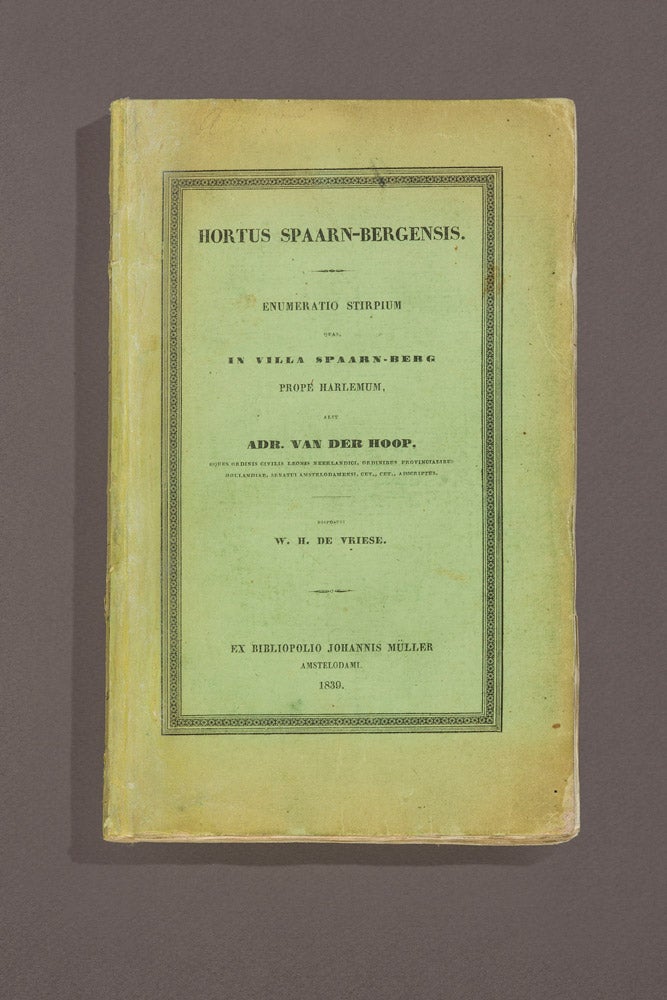Hortus Spaarn-Bergensis. Enumeratio stirpium quas, in villa Spaarn-Berg prope Harlemum, alit Adr. van der Hoop…
Hortus Spaarn-Bergensis. Enumeratio stirpium quas, in villa Spaarn-Berg prope Harlemum, alit Adr. van der Hoop
Amsterdam: Johannes Müller, 1839.
Octavo, two hand-coloured lithographic plates, manuscript presentation inscription to "Lys" (for Cornelius?) van der Hoop in Salzburg; a fine copy in the original printed green glazed-paper boards.
Almost 200 Australian plants in the Netherlands in the 1830s
Rare: a superb copy in the original boards with a family manuscript presentation. This small work by the botanist Willem Hendrik de Vriese is a detailed survey of the truly enormous number of exotic plants being grown at the Villa Spaarnberg, the country estate of Adriaan van der Hoop (1778-1854), a wealthy Dutch banker with a passionate interest in exotic botany: the range of his interests is summed up by the two plants depicted on the fine lithographic plates (a Lily from Japan and a "Theophrasta" from Hispaniola).
Rare: a superb copy in the original boards with a family manuscript presentation. This small work by the botanist Willem Hendrik de Vriese is a detailed survey of the truly enormous number of exotic plants being grown at the Villa Spaarnberg, the country estate of Adriaan van der Hoop (1778-1854), a wealthy Dutch banker with a passionate interest in exotic botany: the range of his interests is summed up by the two plants depicted on the fine lithographic plates (a Lily from Japan and a "Theophrasta" from Hispaniola).
Significantly, van der Hoop and his gardeners had been assiduous in their collection of Australian plants, assembling a remarkable group for such an early date, especially in a continental garden: by our count no fewer than 188 are listed, from grevilleas and banksias through to Gymea Lilies, and even including a scattering of eucalypts and other full-grown trees (full list available on request).
Despite its relevance to Australian botany, we can see no record of a copy being held in Australia.
It is reasonably well-recorded that the Villa's gardens were full of plants from the older Dutch colonies, notably southern Africa and the East Indies, but van der Hoop had much larger ambitions: the truly enormous number of exotics that are noticed in the catalogue is testament to the way in which such gardens had developed from being the preserve of a group of influential amateur botanists in the Georgian era (Sir Joseph Banks, Josephine, Dumont de Courset, etc.) to become an aristocratic fashion by the second quarter of the century, as the great and the good competed with each other to cultivate and record the remarkably long reach of their nurseries.
Such was van der Hoop's passion that he commissioned a young botanist called Willem Hendrik de Vriese to prepare this catalogue of the Spaarnberg garden, laid out in the traditional fashion, with particular notice paid to earlier scientific notices and known details of the original localities of the plants, and some additional nursery notes.
As was always the case with such catalogues, especially those printed with some pretence to grandeur (such as the inclusion of lithographic plates), the size of the edition would have been very small, with many copies reserved for private presentation. Indeed, this volume has an early presentation inscription in manuscript, presenting the book to one "Lys" (presumably for "Cornelius") van der Hoop in Salzburg: given the informal tone, this inscription would have been written by van der Hoop rather than de Vriese.
Provenance: From the van der Hoop family with their inscription.
Landwehr, Studies in Dutch Books with Coloured Plates, 206; Pritzel, 9838; Stafleu & Cowan, 16.397.
Price (AUD): $11,500.00
US$7,510.20 Other currencies


